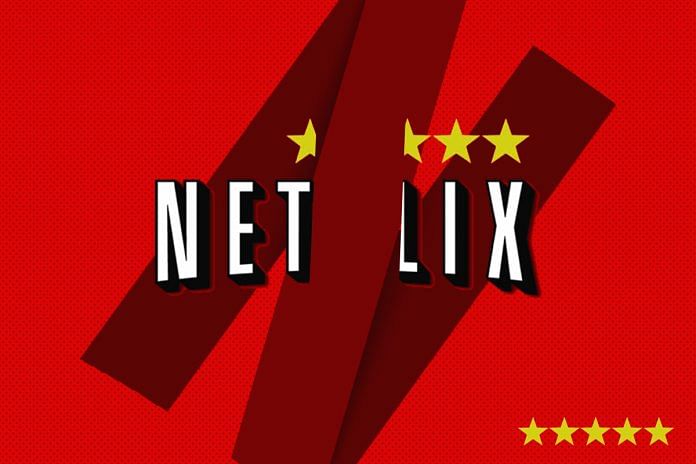With growing subscriber base and buzz, online streaming channels like Netflix and Amazon Prime Video may have created a new kind of audience and entertainment sensibility.
ThePrint asks: Has Netflix created an entertainment divide in India?
Torrents and online streaming created entertainment divide much before Netflix
 Rama Lakshmi
Rama Lakshmi
Opinion editor
There are two kinds of divides in the world of online entertainment in India. And no, Netflix didn’t start this. Illegal downloads and streaming did.
The first divide is between those who watch shows on Netflix, Amazon Prime Video or Torrent, and those who don’t. The second divide is between those who watch Indian content on Netflix and those who watch only international shows.
Over the past year or so, I began noticing friends posting comments about American series they watched on Netflix or Torrent – 13 Reasons Why, Black Mirror, Breaking Bad, Game of Thrones, Dear White People. These posts would immediately be liked, shared and commented on by a bunch of like-minded, big city, English-medium types. Many who devoured Bollywood or patiently waited for American reruns to be aired belatedly on Indian television felt left out.
Meanwhile, there were thousands of others who preferred to talk endlessly about the intrigue updates on Sasural Simar Ka and Bhabhiji Ghar Par Hain during their daily Metro commute. Almost none of them spoke about the American series online.
And then there were those, like me — with poor, patchy internet at home — who wanted in but fell outside this inner circle. It was only when the connection improved that my tryst with Netflix began.
Now the other divide. I only watch American shows on Netflix. Despite the high decibel conversations around Lust Stories and Sacred Games, I didn’t give in. I can get my Bollywood fix at the nearest multiplex or short-movie fix on YouTube. But my Netflix is strictly for what I miss of the US of A. Not for Indian content. That’s the other divide.
Netflix’s entry in India is aiding entertainment divide
 Sharanya Munsi
Sharanya Munsi
Web editor
Good entertainment is what we all seek, but in India its quality is dished out according to one’s class. The higher you rank in the social pyramid, greater is your access to quality entertainment. Streaming giant Netflix’s entry in India is only aiding this entertainment divide.
This gap is being accentuated by the gradual transition of quality entertainment from television screens and theatres to streaming apps in smartphones. While the use of smartphones has seeped through the classes, equal access to paid streaming content of superior quality remains a myth as most cannot afford it.
One of the primary aims of giants like Netflix and Amazon PrimeVideo has been to tap into regional entertainment by creating content in languages like Hindi, Telugu, Tamil and others but their viewership is still restricted to tier one and tier two cities.
One might wonder if quality content spun by Netflix can be comprehended by everyone, but in making this assumption we are being elitist and prejudiced.
It is wrong to assume that only certain classes of people have an affinity for ‘art films’. By assuming that the lower middle classes can only enjoy action films and ghagra choli wearing heroines and not intricate human relationships on screen, we downplay the universal language of entertainment that pervades language and class barriers.
Upper-class bias prevents upcoming online platforms from creating special packages for the economically backward.
Naagin-Narcos divide in India not created by Netflix but high-speed internet
 Diksha Madhok
Diksha Madhok
Digital director
In 2017, I spoke to nearly a hundred students from three IIT campuses—Delhi, Mumbai and Kharagpur—about their favourite shows, and found that almost none of them watched Indian TV. American shows such as Friends, Big Bang Theory, Game of Thrones, Narcos and Westworld ruled the laptops on all three campuses. Not a single of these students had a Netflix or Amazon Prime membership. All these shows were downloaded from Torrent sites.
Yes, there is definitely an entertainment divide in India. The elite, upwardly mobile population prefers American and European shows, which are more realistic in nature with high-production cost. On the other hand, the most watched TV series on Hindi general entertainment channels is Naagin, a show that would be considered grossly over-the-top and regressive by urban millennials. But this divide is created by access to high-speed internet and not Netflix, which has less than one million subscribers in India. By contrast, Hotstar, which has loads of Hindi and sports content, has 150 million monthly subscribers.
During my IIT experiment, I realised that young Indians are desperate for intelligent, modern stories set in their own country. When asked about their favourite Indian shows, they could only list a handful of YouTube series such as Permanent Roommates and The Pitchers (both set in Mumbai). If Netflix really has to create an entertainment divide in India and capture an audience beyond South Bombay or South Delhi, it has to invest in a lot more Indian content in Indian languages. One Lust Stories or Sacred Games is not enough.
Netflix has actually brought diverse content together for everyone
 Yashasvini Mathur
Yashasvini Mathur
Web editor
Before my introduction to Netflix, time off meant switching on the idiot box and going through every channel in the hope of finding one decent show to watch for an hour. The content was subject to what time of the day it was, what was playing, which star’s birthday it was, ad breaks and occasionally, my brother stealing the remote.
Then came Netflix, and life suddenly became easy again. I had the world on my screen. From old Hindi films to the latest English TV shows to documentaries about food, travel, dignitaries and a lot more—Netflix has collated a collection that is not only fun to watch, but also extremely varied in terms of its content.
Do shows that are famous in the West generally get the most coverage on the platform? Yes. But you cannot say that Netflix doesn’t, on their part, try to include and find a platform for diverse content. Search the website a little more, and you’d find spectacular documentaries on Afghanistan and the ISIS. You cannot blame the platform, if you don’t try and hit the search button on it.
Think about it, if Netflix wasn’t there, would series like Ghoul or Scared Games ever see the light of day? The platform is hosting 4,760 titles as found by the website Finder. Films and shows in Marathi, Tamil, Japanese and Korean feature on it too, and with subtitles, giving them a viewership that, perhaps, would never have been possible if not for the platform.
Indian TV tried to match up to Western standards but failed, Netflix had to step in
 Nikhil Rampal
Nikhil Rampal
Journalist
Netflix hasn’t created any new divide in the already bifurcated Indian entertainment industry. It’s just that the platform is new, exclusive (you pay a higher amount than your cable), and has way less censored content than the television.
When you don’t make your own content, you outsource it. Indian TV also did the same for a long time. On one side we had the option to see Kyunki Saas Bhi Kabhi Bahu Thi or Kasauti Zindagi Ki, but we also had an option to watch Baywatch, Friends, One Tree Hill etc., which we outsourced from the West.
Indian TV did try to imitate certain shows that are conceptually Western but failed miserably. CID was a desi version of NCIS (an American crime investigation series). It was very popular in India but it didn’t cater to the Indian NCIS-watching audience because of the overacting, unnecessary sound effects and its poor direction.
It is here that Netflix is making a difference. It is providing quality entertainment sans the typical ‘dhoom tananana’. It is monetising on the area where the home industry strived and failed because of its own incompetence. Clearly, Netflix didn’t create the divide.
Compiled by Neera Majumdar, journalist at The Print.







I agree to the fact that entertainment divide was always there among viewers and torrent and other illegal downloading website played crucial role. What helped Netflix and other streaming giant is rapid internet expansion through jio. Had one been missing, other wouldn’t have flourished.
I totally agree with the views out in by the user “AC”, I couldn’t have put it any better maybe. The simplistic black and white view of things by most of the contributors in the article seems laughable. Blaming internet connection in the first sentence and then blatantly boasting your aversion to Indian content on Netflix just shows the inconsistency in thoughts and reasoning.
The thing about elitism and the “Indian content” on Netflix is a Hollow argument. For example ‘Sacred games’, featured Marathi for a lot of it’s dialogue. The creators said they did not make an Indian series, they only worked on it, because they wanted to create global content based on an Indian backdrop with Indian context. And I come across people from all walks of life, but definitely of a certain age demograph, who thoroughly enjoyed the art that has gone into making the series, a testimony to the fact that everyone can appreciate art if it doesn’t seem too alien or “foreign” in all ways.
I think topic of your article is good but the reasoning is poor.What you failed to mention is that the glorious era of tv still belings to doordarshan.If you go to youtube and search for dd serials you’d be surprise as to the fan following dd serials have.Netflix is only copying wht dd did during it’s heydays when r sagar,br
chopra,kundan shah,sayeed mirza,jaspal bhatti,utv,mahesh bhatt among other greats of hindi cinema made serials that have equal fan following if not more than ekta kapoor.
I watch american serials and movies as well as non english serials and movies but also netflix indian content that yu have mentioned and i enjoyed both as well as watching dd serials on youtube.Yur’e being disingenuos by looking by ignoring dd contribution as well ignoring the fact human beings are diverse lot and in a democracy everyone will watch wht they like not wht others like.I’m sorry to say but your article and the views articulated presents viewing habits of people as black and white and not shades of grey.This article is rather too simplistic based on opinion of certain individuals.Next time onwards please do a little bit of research on topics that yu write abt so that a nuanced view can be taken not a simplistic view which is like a copy paste job.